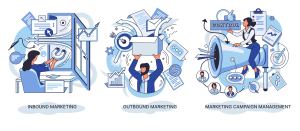Calculated Risks: Navigating the Fine Line between Bold Marketing and Risk Aversion
The business world is often compared to a game of chess; the same could be said for marketing. Every move can advance your position or leave you vulnerable to your competition. Taking risks is an inherent part of marketing, but the key is to take calculated risks with a high chance of success.
The Role of Emotional Marketing in Building Brand Loyalty
Emotional marketing is a type of marketing strategy that aims to appeal to the emotions of consumers. It focuses on creating an emotional connection with the audience, which in turn creates a sense of loyalty towards the brand.
How to Create Compelling Calls to Action: Tips and Examples
In today's world, every brand is competing to grab the attention of their target audience. The internet has made it easier to reach people, but it has also made it harder to hold their attention. Creating compelling calls to action is essential for businesses to drive conversions and boost their ROI.
The Importance of Visual Branding: How to Create a Strong Visual Identity for Your Brand
Visual branding is the process of creating a visual identity for a brand that includes its logo, color palette, typography, imagery, and other visual elements. Any business should have a strong visual identity in order to establish their brand's personality, differentiate themselves from their competitors, and increase brand recognition in the market.
The Advantages of Guerrilla Marketing for Boosting Your Reach
Guerrilla marketing is a unique and innovative approach to marketing that is gaining popularity in today's fast-paced and highly competitive business environment. With traditional marketing methods becoming less effective and more costly, businesses are turning to Guerrilla marketing as a cost-effective and flexible alternative to reach their target audience.
Why Branding is Key to Your Business Success and How to Do it Right
In today's highly saturated marketplace, standing out from the competition is crucial for the success of any business.
Best Practices for Creating Engaging and Effective Digital Ads
The rise of digital advertising has completely transformed the way businesses reach their target audience. From social media platforms to search engines, there are numerous channels through which digital ads can be delivered. However, with so many options available, it can be difficult to create a digital ad that truly engages and converts the target audience.
The Benefits of Influencer Marketing for Small Businesses: Strategies for Growth and Success
The world of business has changed dramatically over the past decade, especially with the rise of digital technology and the growth of social media. As a result, traditional marketing methods have become less effective, and small businesses are searching for new and innovative ways to reach their target audience and promote their products or services.
How ChatGPT Can Enhance User Engagement for Your Website
Chatbots have become an integral part of website design, providing a more intuitive and interactive experience for users. One of the most advanced chatbots is ChatGPT, developed by OpenAI. This cutting-edge technology is capable of providing human-like conversation, making it an ideal solution for enhancing user engagement for websites. ChatGPT's advanced features, such as its ability to understand natural language, make it possible for businesses to create personalized experiences for their customers and increase engagement and retention.
The Rise of Interactive Content: Engaging Your Audience in New and Exciting Ways
The world of digital content is constantly evolving, and businesses must adapt to stay ahead of the curve. Interactive content refers to digital media that allows users to actively participate and engage with the content, rather than simply consuming it passively.
Why Marketing is Important, Now More Than Ever
Marketing has been an integral part of any successful business for many years. Promoting a product or service to potential customers increases sales and builds brand awareness. In the past, marketing was limited to traditional print and broadcast advertising methods. However, with the advent of technology and the growth of the digital age, marketing has evolved and become much more sophisticated.
The benefits of utilizing customer feedback to improve your digital marketing strategy
In today's highly competitive digital marketplace, businesses are constantly looking for ways to improve their marketing strategies and reach their target audience more effectively. One of the most valuable resources available to companies is customer feedback. It is a powerful tool helping businesses tailor their marketing efforts to meet their target audience's specific needs and interests, leading to more effective and targeted marketing campaigns.
How Does Price Have an Impact on Marketing Strategy?
As a digital marketing agency, we are familiar with pricing strategies. Steering away from project-based pricing has been key to our pre-COVID marketing strategy, but in light of changes in the market, the need for pricing based on projects has been in high demand.
AI in Retail Marketing: Personalized Shopping Experiences
Artificial Intelligence (AI) has revolutionized the retail industry, providing retailers with an unprecedented level of customer insights and enabling them to deliver highly personalized shopping experiences. AI technologies such as machine learning, natural language processing, and computer vision are helping retailers to understand their customers' preferences, behavior, and needs. This enables them to personalize marketing campaigns, product recommendations, and in-store experiences.
The impact of mobile-first marketing in a multi-device world
In today's multi-device world, mobile phones have become the primary device for consuming content and making purchases. This has led to a shift in the way businesses approach marketing, with mobile-first marketing becoming the dominant strategy for reaching consumers effectively.
The Impact of the Internet of Things (IoT) on Modern Marketing
The Internet of things (IoT) refers to the connected network of physical bias, vehicles, structures, and other particulars bedded with electronics, software, detectors, and connectivity, enabling these objects to connect and exchange data. The IoT has the potential to revolutionise modern marketing by providing businesses with unprecedented levels of data and insights into customer behaviour and preferences. This technology has the potential to transform various industries, including marketing, by providing businesses with real-time data and insights into customer behaviour and preferences. This can help companies to better understand their customers and tailor their products and services to meet their needs.
ChatGPT: A Next-Generation Content Marketing Consultant
With content marketers hard to find over the past few years and rising salary expectations, the emergence of AI driven content software has been lauded as a life saver. The fast-paced digital landscape is continually evolving with businesses are increasingly relying on content marketing to connect with their target audiences and drive engagement, leads and sales. Creating high-quality, impactful content that resonates with your target audience is a complex and time-consuming process that requires deep expertise and specialised tools.

















